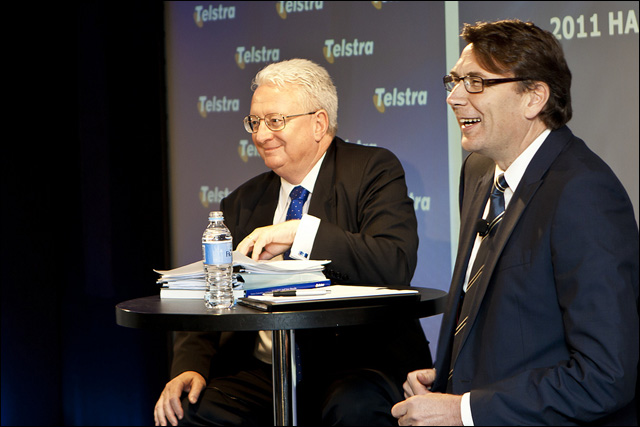The nation’s largest telco Telstra this morning revealed it had “provisionally agreed” key commercial terms core to its agreement with NBN Co, which will see its fixed-line broadband customers and some infrastructure progressively moved into the fledgling company as the National Broadband Network is rolled out over the next decade.
The company has been under pressure over the issue for the past several weeks as it strove to make progress on its complex talks with NBN Co in order to announce some sort of advancement for its half-yearly annual results briefing session in Sydney this morning. It initially signed a non-binding financial heads of agreement with NBN Co on 20 June last year.
“We are working to complete the necessary documentation,” Telstra said in a briefing pack released this morning. “As soon as this is finalised by both NBN Co and Telstra, ACCC and Telstra shareholder approval is required. While there is still work to be done, we are on track to put the proposal to shareholders, with a target date of 1 July 2011.”
However, the telco did not detail precisely what it had agreed upon — other than saying in a media statement that the terms related copper network decommissioning, dark fibre and duct usage, exchange usage and certain roll-out arrangements and other matters with NBN Co. It has also reached an “in-principle agreement” with the Federal Government over the specific measures which were expected to deliver a further $2 billion in value as part of the $11 billion deal.
The news comes as the Financial Review has reported this week that Optus was delaying finalising a deal to transfer its own customers from its HFC cable network onto the NBN until the current batch of NBN legislation was finalised, as well as Telstra’s own deal was detailed. Telstra’s deal includes a stipulation that the company stop providing broadband services over its HFC cable network; Optus owns a similar piece of infrastructure.
Broadband and mobile
In other news associated with the financial results, Telstra appears to be continuing to deliver on its promises to grow its share of the fixed-line broadband sector, considered to be a mature market due to the fact that most Australians now have access to broadband.
Telstra has recently conducted a “fightback” marketing push into the broadband area — which has seen it cut plan prices drastically and boost quotas on its offerings, in an effort to make them more competitive in the market. The telco has also introduced a range of bundled offerings with its other product lines — for example, mobile.
At its annual results briefing in September a trend in the area was already visible. In the first two months of the financial year, Telstra added 32,000 fixed broadband customers, compared with a net loss in the previous year). Today that trend expanded — Telstra added 139,000 broadband customers over the six months to the end of 2010. And the company is suffering lower churn to other providers, as well as a strong impact from its new cross-service bundled offerings.
The company’s flagship T-Box and T-Hub products were also doing well — with the company selling 128,000 T-Hubs in total since they launched in mid-2010, and 107,000 of its T-Box media centres. The company’s mobile business based on its Next G network also continues to expand — with some 919,000 customers being added to its ranks over the six months at the end of last year.
As part of that, Telstra added some 505,000 mobile broadband customers in the period — giving it a total mobile broadband base of 2.2 million customers. The numbers of prepaid mobile broadband customers are especially growing fast.
Smartphones were also a big driver of growth for Telstra — in the six months to the end of last year, seven of its top ten-selling post-paid handsets were smartphones. The telco led Australian’s adoption of Google’s Android operating system in 2010 with flagship handsets like the HTC Desire.
The financials
Despite all of the positive growth, Telstra’s financial situation continues to depreciate. The company suffered a dip in total revenue of 0.5 percent year on year, with total revenues being $12.3 billion. Operating expenses rose 10.7 percent to hit $7.8 billion, and earnings before interest, taxation, depreciation and amortisation sank 13.9 percent to $4.5 billion — more than the forecast 12.5 percent.
Telstra’s free cash flow was also down — to $2.02 billion, from a previous $2.62 billion.
To address this, Telstra chief executive David Thodey has outlined a four-pronged strategy, focusing on improving customer service, retaining and growing Telstra’s customer base, simplifying its business and investing in new growth businesses.
Today, the telco said it had record a 1.3 percent improvement in its customer satisfaction rating, and hailed its success in broadband and mobile as evidence of its ability to keep its customer base and even grow it. Its Project New internal transformation project was also moving forward, and Telstra said it saw growth opportunities in media, network applications and services (cloud computing) and in Asia.
“Our focus remains on organic growth, although we would consider small acquisitions if they create clear value for our shareholders,” the telco said in briefing documents. “We recognise the need to translate this customer momentum into revenue and profitability, but with customer base a leading indicator of financial performance, we believe that our strategy remains on track.”
Stay tuned for further coverage throughout the day of Telstra’s financial results press conference.
Image credit: Telstra


Haven’t they been “focusing on improving customer service” for something like the past half decade?
This is good progress. Takes all dodgy questions about “potentially low NBN uptake” out of the equation.
Comments are closed.